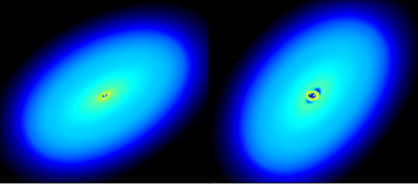Bending and breaking protoplanetary discs around a binary star
The environment in which stars and planets form is highly dynamic. Stars commonly form in binary or multiple systems within a vast cloud of molecular gas. Stellar systems are always on the move due to the initial turbulence and rotation of the gas that they formed from. Most young stars host protoplanetary discs, made up of gas and dust and from which planets form.

Discs around binary stars are not always aligned with the orbit of the binary, perhaps because they have been tilted by the gravitational pull of another star passing nearby. We have observed binary-disc systems like this with telescope facilities such as ALMA and the VLT. Some of these have separate, misaligned inner and outer discs and others have a more smoothly warped structure. These structures can be generated when the protoplanetary disc surrounds a binary star system and orbits in a different plane to the binary. This misalignment results in a gravitational torque that makes the disc precess like a gyroscope. Because precession is a steep function of radius, concentric rings within the disc precess faster the closer they are to the star. This causes the disc to become warped and this warp perturbation travels through the disc as a bending wave (i.e. protoplanetary discs are in the “wavelike” regime of warp propagation). If the warp cannot be communicated effectively through the disc then the disc may tear into two components (see image on the right).
We ran a number of high-resolution simulations to determine the circumstances in which a protoplanetary disc might tear. We found that no single parameter can predict whether or not a protoplanetary disc will break. It is the combination of factors, such as misalignment angle between the binary and disc planes and the radial temperature profile of the disc, that matters. We can, however, rule out an unseen planetary companion within the disc cavity as a cause of disc tearing since we don’t observe disc breaking for a mass ratio of 0.1 (Disc on the left of image). In other words, if an object is massive enough to tear the disc, then it will be bright enough to detect.
At the moment, we don’t have an accurate analytical prediction of where a disc breaks (the breaking radius) in the wavelike (protoplanetary disc) regime. We showed that the expression derived by Nixon, King & Price (2013) significantly underestimates the breaking radius. The reason for this, it turns out, is that the precession torque acting locally in a disc is not solely due to the central stars. The bending wave launched near the inner edge of the disc efficiently transports the torque outwards. Consequently, the precession torque in the disc is greater than the analytical expression predicts which means that the conditions where a disc is susceptible to breaking occur further out in the disc than expected.
This brings us a little closer to explaining some of the strange features we have seen in images of protoplanetary discs. These simulations give us indications of what to look out for and measure to determine the origin of a broken protoplanetary disc.
Credit: This work made use of DIaL2 at Leicester, dp269 “Fragmenting protoplanetary discs in the cluster environment”. It is published in Young et al. (2023).

